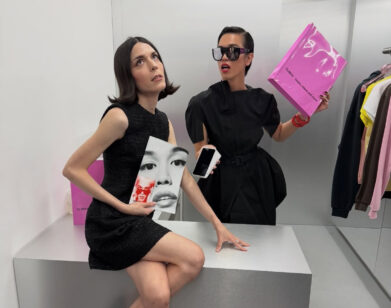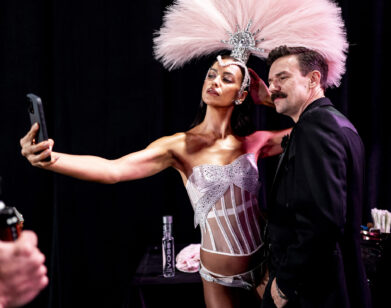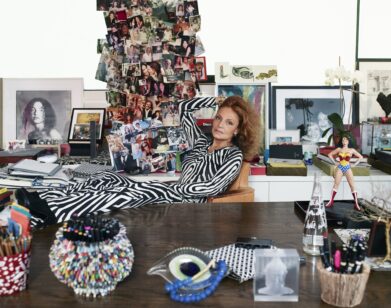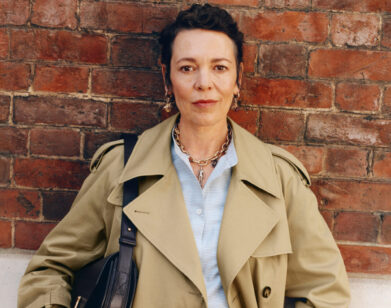Pop-Master: Jean-Charles de Castelbajac
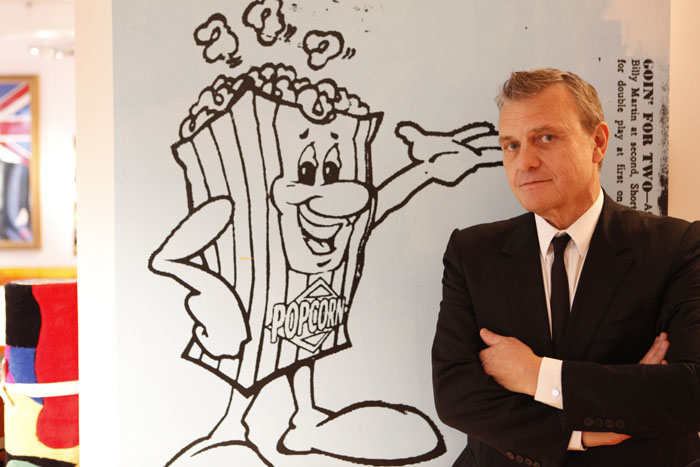
PHOTO BY HUGO DE CASTELBAJAC
Jean-Charles de Castelbajac’s influence range from Mickey Mouse to Louis the XIV and Malcolm Mc Laren. His clients range from M.I.A. to the Pope and Annette Messager. Since his design career popped in the 1970s, he has brought stuffed animals, street art, and scotch tape onto the conservative Parisian catwalks. Today, he continues to be a reference and a mentor to the young French generation. We met him hours before the show and talked about Wikipedia, post recession, and low-cost luxury.
ALICE PFEIFFER: What are we going to see in the show?
JEAN-CHARLES DE CASTELBAJAC: It’s called Über Tropical Airlines, and it deals with exoticism, lightness, travel, which is something I never really worked on before—I usually focused on using and disrupting my own culture, pop codes. There will be elements of colonialism, voodoo. You’ll see.
PFEIFFER: You have just launched your site, JCDC store, where one can buy slightly more affordable Castelbajac clothes online…
CASTELBAJAC: Yes, that was very important to me, to pass on something to the next generation. The new generation hasn’t been given all the elements it deserves: brands scatter a few initials on a pair of y-front for an affordable price, offering a second line which is just the trashcan of another, more sophisticated line. I wanted to make something beautiful and affordable—and I feel close to Marc Jacobs’ approach in that respect.
PFEIFFER: You’ve introduced legos and graffiti onto French catwalks. But how do you surprise the youth of today?
CASTELBAJAC: Surprise comes as an accident. I don’t have a simple vision—it’s like if I had a prism in my subconscious mind that hijacks what I see around me. I create a mise-en-abyme with things I see, and then appropriate and transform them. My sources of inspiration are history, that I appropriate like a parcel of collective memory—preferably something gloomy—that I then bring back to my own century to turn it into something modern.
PFEIFFER: You work with young photographers, how do you keep up with the next generation?
CASTELBAJAC: You know—all the kids today, André, Pedro Winter or Jeremy from Surface to Air, I’ve known them for ten years. Pedro did his first DJ set for me, André his first love graffiti for a girlfriend. It’s like an ‘anti-nostalgia’ generational community, and it’s fun seeing them today.
PFEIFFER: You follow blogs and have a Facebook account, what appeals to you about the Internet?
CASTELBAJAC: It’s extraordinary to think that I can juggle, between Wikipedia and the Battle de Hastings, YouTube and Crystal Castles’ latest video. It’s a perfect tool for me. It’s also fascinating to see how people like Jean-Michel Basquiat, who I knew well, have been adopted by this new generation. Or Keith Haring, who used to play games of Cadavre Exquis (Consequences) with my sons. So internet is a ghost buster.
PFEIFFER: How has fashion evolved since you entered the business?
CASTELBAJAC: When I started off, it wasn’t purely about fashion: the designers wanted to get on stage, have a riot. There was a heroic aspect to it. But by the 80s a parameter we hadn’t considered that much came in: money. So we watched the transformation of our art into an economy. And by the 90s, it was a business, and had turned into a substitute for monarchy—it had a new power, its own rules and rituals. It has something sovereign about it: its admirers, its court, its aesthetic regime.
PFEIFFER: And today?
CASTELBAJAC: Well, fittingly, this monarchy saw its own revolution: low cost luxury, or what Karl Lagerfeld calls Mastige, mass prestige. Because generosity is to the Twenty-First Century was arrogance was to the 1990s. Recession has brought this upon up, the new economy is linked to a collective conscience. All for the best.



